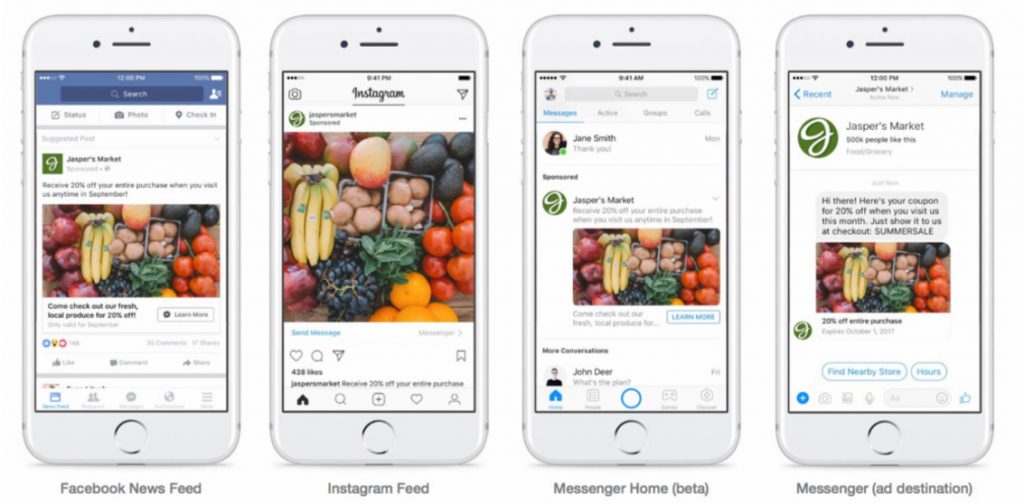What is Facebook Messenger Advertising?

Facebook’s Messenger app boasts 1.3 billion active users and is currently the largest messaging app in the U.S. Now is the time to decide if advertising in the app is right for your business. Outlined below are current advertising opportunities and requirements.
Every month, 2 billion messages are sent between businesses and people on the Messenger app according to Facebook’s internal messaging data. People are using Messenger more and more to communicate with businesses; businesses are noticing the tool’s positive impact on customer retention and sales. Growth within Messenger shows no signs of slowing: in a Facebook-commissioned Nielsen study, 61% of the people surveyed said they like getting personalized messages from businesses, and 67% said they expect to message business even more over the next two years.
How Facebook Messenger Advertising Works
1. Sponsored Messages on Messenger Home Screen

The easiest way to start testing ads on Facebook Messenger is to run sponsored messages on the Messenger home screen. These sponsored messages are served before and after conversations and are labeled ‘sponsored’ above the advertiser’s name. There are three primary ways advertisers can start testing ads within messenger.
If Messenger is already something your consumers are leveraging, advertisers can include Messenger as a placement in current campaigns using existing targeting and creative. Facebook will automatically optimize this placement to get the best campaign results. You can also compare Messenger results vs. News Feed results in reports.
2. Click-to-Messenger ads
Advertisers can run a specific campaign encouraging users to communicate via a click-to-Messenger. This approach allows consumers to ask questions and makes it possible for brands to provide support in the moment.

Considering 53% of people are more likely to buy from a brand if they can message them directly, this type of ad unit offers a seamless solution, allowing people to communicate directly via Facebook Messenger. The opportunities are endless and will continue to expand over the next few years.
Customer engage by clicking the CTA button to start a conversation within the Messenger app. Call-to-action buttons include the following: See Menu, Apply Now, Book Now, Contact Us, Get Showtimes, Learn More, Request Time, Send Message, Watch More, Subscribe, Sign Up, or Shop Now. Once a conversation is started, your target audience is served an automatic message created at campaign setup.
Businesses can then interact with each person individually, answering their questions or scheduling future appointments using live chat or a bot for Messenger. One great example of Messenger use is Sephora, who used click-to-Messenger to streamline their booking process. By allowing customers to book in-store makeovers using an automated experience built on the Messenger platform, Sephora reported an 11% increase in appointment book rate.
3. Sponsored Messages to Active Messenger Conversations
The third option delivers sponsored content to active conversations with the Messenger feed. This is a simple and effective way to inform current customers about upcoming sales and promotions. Sponsored messages can only be sent to customers who have already connected with your business via Messenger, so audience size needs be large enough – aim for 1,000 individuals – before a sponsored message makes sense. This type of ad is recommended for advertisers that are already running click-to-message ads or have a very large following.
Facebook Messenger Advertising Is a Unique Way to Reach Customers
Facebook Messenger can be a unique and powerful way to connect with your customers. There are reportedly over 200,000 bots now live on Facebook Messenger helping businesses automate different kinds of conversations with customers – a trend that is only expected to grow. But if you’re new to Messenger and your business isn’t ready to develop a Messenger bot or run click-to-message ads, there are still ways to step your toe into messaging – for example, testing a Messenger home screen placement as a complement to current campaigns is a good place to start. Then, if your audience is receptive to your ads, Messenger could provide another opportunity to expand your current audience reach and help you find new customers that are more active on Messenger than on the News Feed.
The future for Messenger is bright. It’s highly likely Facebook will make additional investments in Messenger ad capabilities – this means marketers can expect more enhancements within the messaging app, which will make it more appealing for consumers and businesses alike.
Photo Source: Facebook



